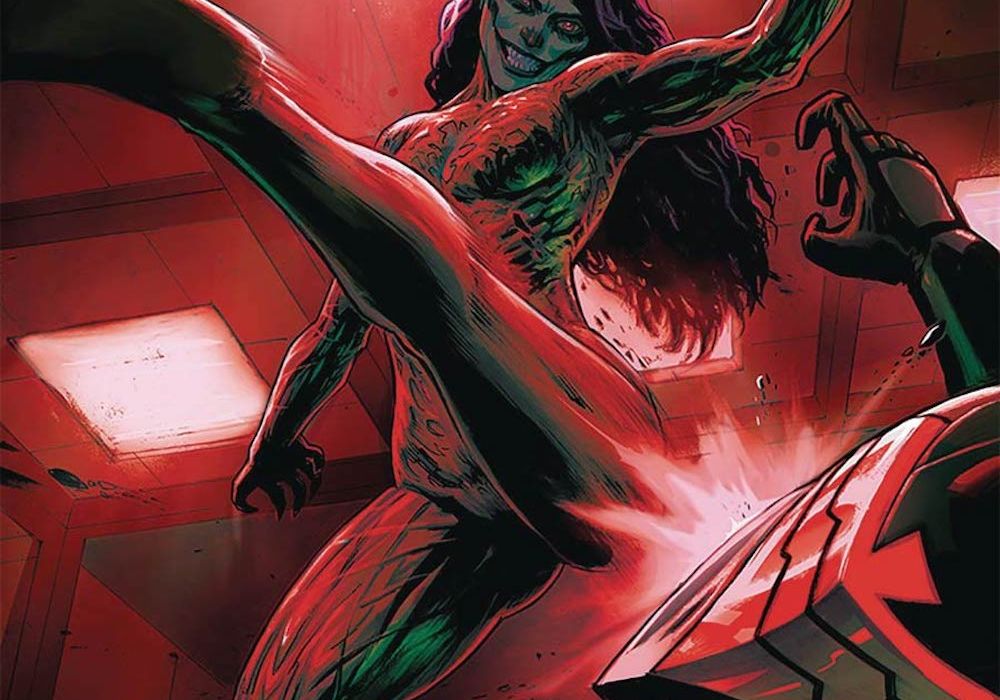Violence and family abound in “Cyber Force” #2.
Written by Bryan Hill and Matt HawkinsCover by Atilio Rojo
Illustrated and Colored by Atilio Rojo
Lettered by Troy PeteriStryker must reconcile with what he’s become…and what’s been done to his daughter Carin. There’s little time for either of them, as the villain that threatens the world seeks to draft someone else to her cause: Killjoy.
With this second issue of the “Cyber Force” retool, Bryan Hill and Matt Hawkins pull back on tormenting Stryker and his daughter Carin to focus in on some of the other problems throughout the high-technology elements of the renewed Top Cow world.
First and foremost is the father-daughter relationship between our two apparent leads. Hill and Hawkins present a duality that resonates well with any parent-child relationship, one that seems to bend more toward the latter than the former in terms of bias, but not without giving a hefty amount of weight behind Stryker’s position either. Hill and Hawkins show that Stryker, with his grown cynicism over the course of his life, or perhaps just realism, understands that all of the cyborgs being created are just war machines. As human as any father in spite of his quarter-cybernetic body, he doesn’t want his daughter to be thrust into war as he is willingly going, and, less reasonably, seems to be just fine guilt-tripping his formerly paraplegic daughter over her choice to save his life and renew the use of her own legs. However, Carin actually wants to help out and be useful, showing more hope, altruism, and a closer bond through kindness.
A major focus in the writing is Hill and Hawkins’s differing perspectives on cybernetic enhancements depending on each character’s personal experience and how that belief system seems to dictate their powers as much as their enhancements themselves. Stryker sees them as a necessary evil, given he never had any choice in the matter, and himself as nothing but a war machine, with Carin being likewise affected. Perhaps to demonstrate his lack of enthusiasm for anything but revenge, his abilities seem to be primarily strength based. On the other hand, the fact that Carin is not only overjoyed at her newfound superhuman abilities, but actually wants to help, lends a bit less credence to the “cyborgs are just war machines” mentality, and more toward an air of wonder. Accordingly, her own powers seem to be around superhuman speed and agility, given her new legs.
The antagonists form the other half of the story, and are… a bit disjointed, be it on purpose or not. Their mentalities seem to be based in hypocrisy wrapped around beliefs of misogyny, ones that fall apart as one looks at the father and daughter listed above. The Accuser and Killjoy each are monstrous in their own ways, but Hill and Hawkins have their violent acts and possible goal moving forward based in the idea that they were abused for being women and treated poorly as a result, to the point of their (or at least Killjoy’s) horrific augmentations. Considering that Stryker’s opinion of the same organization is not particularly high (to say the least about his paranoia) and Carin is treated with respect and given everything she wanted (along with the revelations about Killjoy’s history not exactly doing her any favors either), this argument fails pretty badly. Hopefully our writers can figure out a wider ranging thought process for the villains, especially with the famous character coming up shown in the last page, so as to avoid them being too one-note… unless the villains really do have a point.
Atilio Rojo’s artwork is fantastic, both in its pencils and its colors. The realism in the faces helps to sell the varied facial expressions, from the most human kindness and determination in Carin to the borderline inhuman overprotective nature of Stryker with his half-cybernetic face, to the monstrous sociopathy and even pitiful nature of Killjoy.
One of the highlights of the artwork is the way in which cybernetics are drawn. Rojo excels at making the silver musculature into a streamlined, almost organic mechanism for each limb, albeit just a bit too strong to be natural, especially in the case of Carin’s new legs. The entire feel of it is similar to the mechanical augmentations in Adam Jensen’s Deus Ex video games, a welcome comparison that grants more possibilities and implications as to the powers available to the Cyber Force and their antagonists.
Continued belowSilent artwork helps to show the extreme violence, unhindered by unnecessary dialogue. Rojo presents severed limbs and heads with minimal context to how they ended up that way to showcase the horror of the Accuser’s assault on Killjoy’s prison. Spurts of blood enhance the horror of the combat far more than outright severing of limbs would have done in that situation, and the visceral nature of the combat, including the use of an alarming shade of red in the area where most of said combat takes place, helps to keep the feeling of unease high as the superhuman, inhumane nature of the cyborgs is made absolutely clear in a way that is not necessarily present in the calmer times of the father and daughter.
On the whole, this issue is a good followup to the premiere of this take on “Cyber Force,” a welcome renewal of the concepts of the series for a new era.
Final Verdict: 7.5– A well-handled continuation of the family drama, albeit with a bit of an odd villain motivation that might fall apart on too much analysis.




